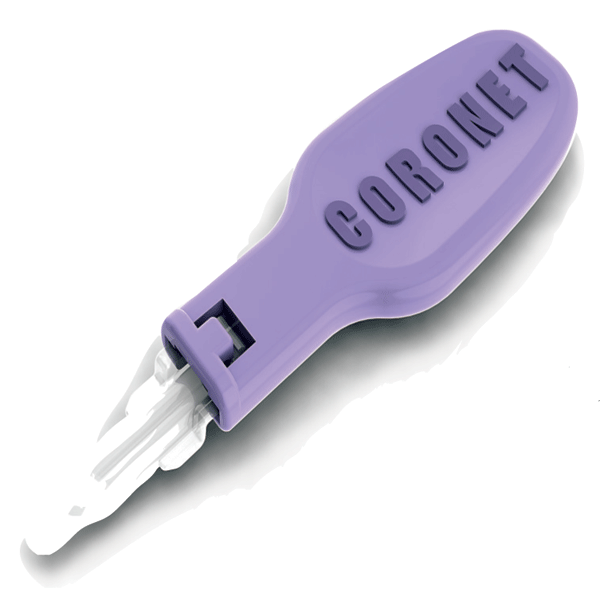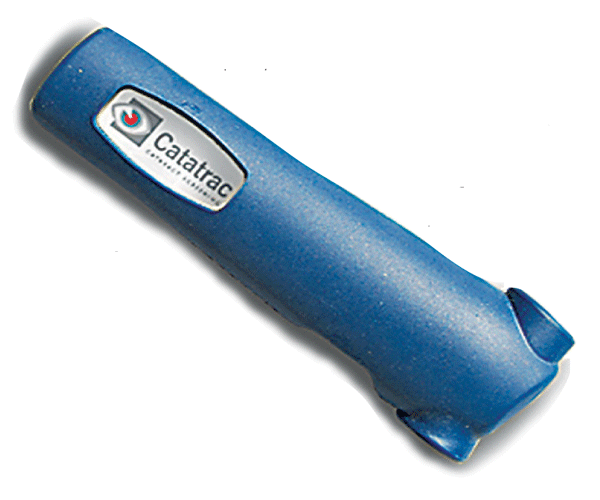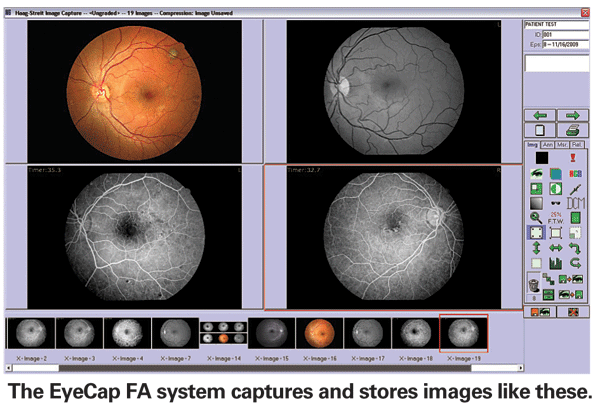If you're looking for a gentler way to manipulate endothelial tissue in manual or automated Descemet's stripping endothelial keratoplasty, Angiotech (Vancouver, B.C.) says the Tan EndoGlide may be able to help. The company says the device reduces the iatrogenic damage done to donor endothelium that can result from manipulation and insertion through a small incision. The secret is a patent-pending cartridge that produces what the company calls a "double-coil" loading of the donor tissue, causing minimal endothelial touch. The EndoGlide allows the surgeon to maintain full control of the lenticule during all phases of insertion, Angiotech says. The device itself is manufactured by Coronet Medical Technologies (North Yorkshire, U.K.). Angiotech distributes the device as well as the Sharpoint brand of products in the

A Polarizing Issue
M&S Technologies has added polarization testing to its LCD computerized vision testing system, the Smart System 20/20, which is designed to replace static eye charts and manual eye-chart projectors. The company says the addition of polarization to the Smart System gives the physician the ability to perform binocular testing, fixation disparity and suppression. For information, call 1 (877) 225-6101 or visit mstech-eyes.com.
New Dry-Eye Treatment
Wilson Ophthalmic recently introduced a new entrant into the dry-eye market: Avitears. The company says the tear increases tear breakup time, restores osmolarity, scavenges free-radicals and helps promote tear flow and tissue healing. For information, call 1 (800) 222-2020 or visit wilsonophthalmic.com.
Gulden Ophthalmics Handheld Catatrac
Gulden Ophthalmics says its new handheld Catatrac cataract screening tester is simple and fast to use, especially for screening large numbers of patients swiftly while also offering an effective way to screen infants and children.
The device uses retroilluminiaton to detect cataracts. It can help detect congenital cataracts in newborns and young children before the cataracts negatively affect their development and learning. It is ideal for screening elderly patients in assisted living and nursing homes as well as community screenings at adult day centers. With less than a half-hour training, doctors, nursing staff and other medical workers can easily screen for cataracts as effectively as an ophthalmoscope.
In rural clinics where ophthalmic services are only sporadically available, Catatrac can be used effectively by lo-cal health-care workers to perform first-line screening.
The device is ergonomically designed for repetitive use; its light weight and compact size (less than 8 inches in length) make it ideal for mass screenings. Powered by two AA batteries, with a battery life of more than 2,000 screenings.
For information, call (215) 884-8105, email: info@guldenophthalmics.com or visit guldenophthalmics.com.

Haag-Streit Distributes Canon Mydriatic Retinal Camera
Haag-Streit is now distributing Canon's CF-1 mydriatic retinal camera for use with its EyeCap FA image management system.
Created for general ophthalmology and specialty applications, the EyeCap FA imaging system captures and stores images from retinal cameras, including the Canon CR-1. The EyeCap FA system securely manages the entire ophthalmic imaging resources of a modern eye-care practice, by interfacing with other Haag-Streit devices such as slit lamps. It also improves practice management by making it easier to track patient records.
The system enables practitioners to annotate notes directly onto the images and incorporates diagnostic tools that enable precise measurements and tracking. It provides multiple views, including thumbnails and side-by-side. The EyeCap FA system also is network-ready and secure.
The Canon CF-1 mydriatic retinal camera provides high-resolution color, red-free and fluorescein angiography imaging. Its user-friendly control software was designed for efficiency and may increase patient throughput. For information, visit haag-streit-usa.com.

New B&L Instruments for MICS and Retina Surgery
Bausch & Lomb Storz Ophthalmic Instruments has announced the
Also released by B&L Storz is a new single-use endgripping forceps for vitreoretinal surgery, available in 23- and 25-ga. options. This endgripping forceps is designed for safety, consistency and convenience. It features an ultra-thin endgripping tip for enhanced visibility and grasp with a sleek, ergonomic handle consistent with the popular Storz Ophthalmics reusable design. The balanced design provides optimal feel and control, the company says. Both the 23- and 25-ga. versions are available in boxes of two and six for facility convenience.
For information on either product, visit storzeye.com or call customer service at 1 (800) 338-2020.
Oasis Introduces the Optyse Lens-Free Ophthalmoscope
Oasis Medical offers a new lens free ophthalmoscope for simplified retinal screening. The Optyse Lens Free Ophthalmoscope provides a rapid and clear view of the retina and requires no lens adjustments. Oasis says the instrument is excellent for posterior pole, disc and macular viewing with a clear enough image to detect smaller lesions. The magnification and field are comparable to a standard direct ophthalmoscope. The light-weight, pen-sized device can be carried in a pocket and operates with two triple-A batteries. For information call Oasis at 1 (800) 528-9786 or visit oasismedical.com.
Pearls from the Deep
Some Pearls for Better Micro-Incision Cataract Surgery
The new 1.8-mm phaco tips and the new Akreos MI60L intraocular lens bring on a whole new set of challenges, along with a small learning curve.
Smaller incisions require modified surgical instruments. Still, the architecture of the incision, in my opinion, is the most important part of the surgery. There are several new asymmetrical diamond knives to ensure a self-sealing incision. My choice is the D.S. 1.8-mm MICS made by Magnum Diamond, LLC. It has an asymmetrical, beveled diamond blade, which allows a reproducible, tight fit for anterior chamber stability, and produces a self-sealing wound by just lifting the handle before you enter the chamber.
The capsulorhexis is also important. Learning to do it from a micro-incision can be challenging. The trick is to learn to let the vault of the cystotome help you make your initial tear and grasp the capsule without stretching the wound. For those who like forceps, you need to find a pair that have very thin shanks that are less than 1 mm wide in the closed position; and they should have a maximum spread of 2 mm so you don't stretch the wound. My initial use of a retinal membrane peeler was very effective but I have found that just a cystotome works well in my hands. I think the ideal capsulorhexis size is about 6 mm for my technique, slightly larger for premium lenses.
Hydrodissection and hydrodelineation are the same as with larger incisions. When starting phacoemulsification, the easiest way to get the phaco tip into the tight incision is to place a little viscoelastic at the incision opening and insert with bevel down; it will be tighter than you are used to so insert it slowly. I use a straight tip; you can use a Kelman tip, but it is a little harder to get into the wound.
Phaco with the new MICS Stellaris Vision Enhancement System by Bausch & Lomb is
very efficient and allows for a stable chamber and less BSS to run through the eye to reduce endothelial cell loss. I/A is slightly different: You have to torque your hand a little to reach all the cortex superiorly. I have found that putting a cortex extractor on the aspiration port through the side-port incision (like bimanual) makes 12 o'clock cortex removal easier.
Inserting the Akreos MICS MI60L through a 1.8-mm incision was the hardest part of the learning curve for me. It went against everything I have strived for: no disruption of the wound and smooth, controlled, slow insertion. Initially I used wound assist with a second instrument in the side-port incision, but I soon learned that was harder for me to do. I just couldn't push and pull at the same time without feeling like I was going to damage the cornea or the wound. Now I just place the inserter right at the wound lip, press down slightly, ask the patient to look up and slowly insert the two leading haptics into the bag and deliver the trailing two haptics with a Bechert or any instrument you feel comfortable with. This lens looks beautiful in the eye, it centers perfectly.
I think smaller is better. The wound seals more easily, and there is decreased endothelial cell loss and little or no induced surgical astigmatism. It is safer for the patients with reduced healing time. To me a learning curve is a small price to pay for a small incision with large benefits.



